Cambodia
Things to DO
Kompong Thom
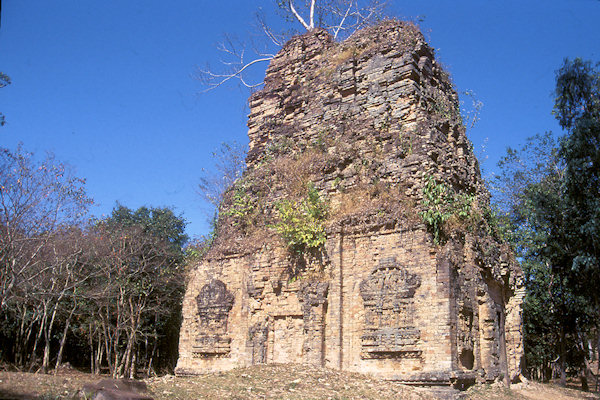 |
|||||
The Chenla Kingdom rose to power in Cambodia in the 6th century AD. The Chenla were ethnic Khmers who migrated to southeast Asia
in AD 550 from what is now Yunnan, China and northeast India.
In 618 King Isanavaram established Sambor Prei Kuk as the capital of the kingdom (at that time the city was called
"Isanapura").
Sambor Prei Kuk contains approximately 150 temples and towers, remarkable for their architectural and artistic achievements:
achievements that predate Angkor Wat by several centuries.
The majority of these temples have fallen into a severe state of disrepair. Vandals and relic hunters have pillaged the site,
stealing much of the statuary from the structures.
US bombing in the early 1970s completely destroyed a number of temples, and those remaining have been invaded by the jungle surrounding
them. Trees sprout from temple walls, vines hang from roofs, and creatures have burrowed their ways through the brick and sandstone.
 |
|||||
Prasat Sambor
The principle group is dedicated to Gambhireshvara, one of Shiva's many forms. The other groups are all dedicated to Shiva
himself. Several towers here retain carvings in a reasonable condition.
Prasat Yeay Peau
The Southern Group contains some of the best structures at the site. Eight octagonal towers and ancillary gate-lodges comprise the
impressive group of buildings.
The exterior walls of the towers are adorned with sculpted brick panels, about two metres high, called Flying Palaces. The
panels contain relief carvings of outstanding quality, although badly damaged.
Prasat Tao
Praset Tao, boasting the largest of the structures, means Lion Temple, and there are two excellent examples of Chenla carving in the form
of two large elaborately coiffured lions.
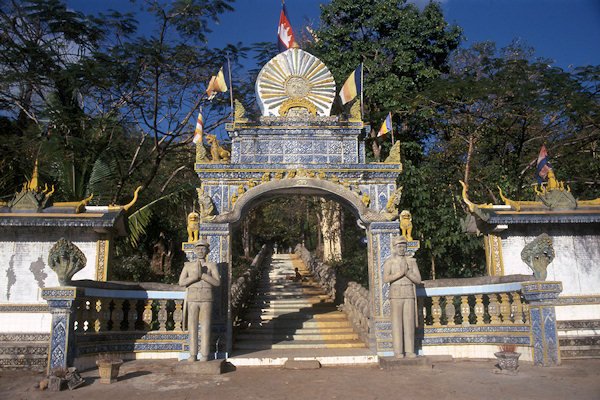 |
|||||
Phnom Sontuk
Phnom Sontuk is the most important holy mountain in this region and the hillside is decorated with Buddha images and a series of
pagodas.
It is an attractive location, set high above the surrounding countryside, but this means there is a lot of stairs to climb - 980, in
fact. The stairs wind their way up through a forest and emerge at a colourful pagoda that has many small shrines (quite unlike
other shrines around Cambodia).
There are a number of interesting sandstone boulders balanced around the wat, into which have been carved images of Buddha.
Just beneath the southern summit of the mountain are several large Reclining Buddhas - some modern incarnations cast in cement, other
carved into the mountain itself centuries ago.
There is an active wat on the mountain and the local monks are always interested in receiving foreign tourists.
Phnom Udong
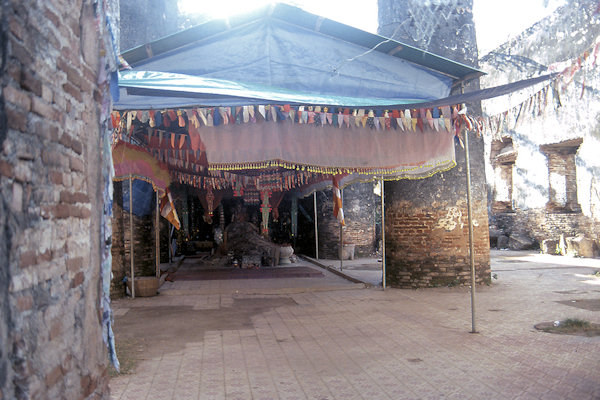 |
|||||
Udong ("The Victorius") served as the capital of Cambodia under several sovereigns between 1618 and 1866. A number
of kings, including King Norodom, were crowned here.
The large ridge Phnom Preah Reach Throap ("Hill of the Royal Fortune"), is so named because a 16th-century Kmer king is
said to have hidden the national treasury here during a war with the Thais.
The most impressive structure on the ridge is Vihear Preah Ath Roes. The Vihara and the Buddha, dedicated in 1911 by King
Sisowath, were blown up by the Kmer rouge in 1977; only sections of the walls, the bases of eight enormous columns ant the right arm
and part of the right side of the Buddha remain.
Vihear Preah Ko, a brick-roofed structure contains a statue of Preah Ko, the sacred bull; Vihear Preah Keo, has a seated Buddha
inside.
Chet Dey Mak Proum is the final resting place of King Monivong
(r 1927 - 1941). decorated with "garuda" (mythical half-man, half-bird vreatures), floral designs and elephants, it has four
faces on top.
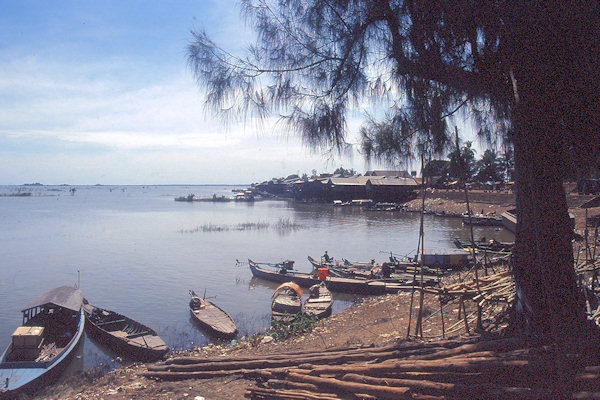 |
|||||
Kompong Chhnang
The name Kompong Chhnang comes from the local claypots ("Chhnang") made in the villages around the town ans sold throughout
Cambodia and from "kompong" meaning port (thanks to its location on the Tonlé Sap river)
The town has nothing beyond atmosphere to offer the cas-ual visitor, but for those with limited time who want a feel of provincial
Cambodia, it makes for a pleasant transit stop between Phnom Penh and Battambang or an aesy day trip from the capital, stopping at
Udong along the way.
Kompong Luong
 |
|||||
The floating town of Kompong Luong on the Tonlé Sap lake is arguably one of the most interesting places to visit in Pursat
Province.
It's a town of as many as 10.000 inhabitants who live permanently afloat on the lake. The town moves with the level of water in the lake,
as recognised by a faded signpost on NH5 to Kraktor, which states that the distance to Kompong Luong is maximum 7km , minimum 2km.
The population is predominantly Vietnamese; there are plenty of places to stop for an iced coffee or a beer and just soak up the
atmosphere of life on the water.
Battambang
 |
|||||
Cambodia's second-largest city is an elegant riverside town, home to some of the best-preserved french period architecture in
the country and to warm and friendly inhabitants.
The central area is bordered to the west by the railway line and to the east by the river Stung Sanker. Across the river are several
large properties serving as administrative centres for the large numbers of NGO's represented in the province.
Many of the motto-drivers who hang out at the popular hotels speak excellent English and have a good knowledge of the province. They can
take you to the temples, but also can show you a slice of local life in the farming communities around town.
The moto-drivers mostly include also a Lorry Ride. These are a sort of local train built from wood and powered by an electric
motor. They can be used for short hops up and down the lines between Battambang and Pursat, and are a fun experience providing you
don't run into a train. Sadly, rumour has it that they will soon be banned from the line.
 |
|||||
Phnom Sampeau
Phnom Sampeau, ("Sailingboat mountain"), is a striking limestone outcrop, about 18km southwest of Battambang.
On the hill are a number of temples, mostly destroyed by the Khmer Rouge, but currently being rebuilt.
More impressive, however, is the cave in which lots of people were killed by the Khmer Rouge. The bones and skulls are collected
and exhibited in a cage as a monument.
Up till 1997 the Khmer Rouge was still present around Pailin near the border with Thailand, from which they attacked the region
around Battambang.
On the mountain, there is still artillery pointed in the direction of "Crocodile Mountain" 500 meters further, which used to
be a stronghold of the Khmer Rouge.
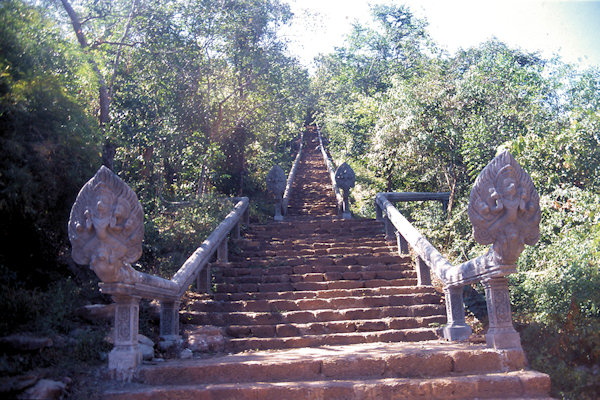 |
|||||
Wat Banan
Wat Banan, with the torment of another mountain to climb to receive the reward! This time there were 359 ancient Khmer stone steps,
leading to the summit and temple.
Built in the 11th century by Udayadityavarman II, this hilltop temple offers incredible vieuws across the surrounding
countryside.
Wat Banan has five towers pointing skyward and is like a smaller version of Ankor Wat; there are several impressive carved lintels
above the doorways of each tower.
A visit to Wat Banan (about 25 km south of Battambang) can be combined in a loop with Phnom Sampeau, making it a nice day trip.
Siem Reap
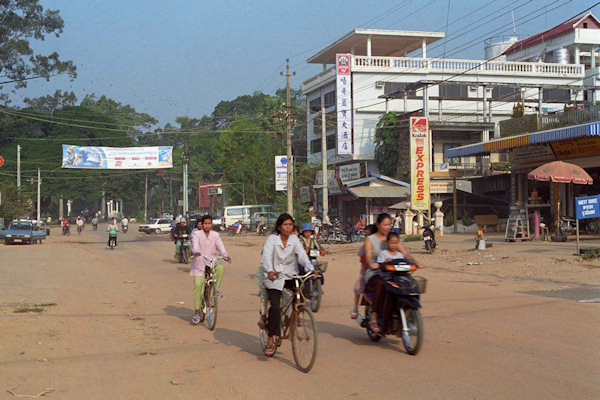 |
|||||
Siem Reap is the gateway to the temples of Angkor.
The name "Siem Reap" can be translated to mean "defeat of Siam", and is commonly taken as a reference to an incident
in the centuries-old conflict between the Siamese and Khmer kingdoms, although this is probably apocryphal.
According to oral tradition, King Ang Chan (1516–1566) had named the town "Siem Reap" after he repulsed an army sent to invade
Cambodia by the Thai King Maha Chakkraphat in 1549.
The Old Market or Psah Chas is between Pub Street and the Siem Reap River, and offers a mixture of souvenirs for tourists and
a variety of food produce and other items meant for the locals.
Several restaurants and hotels offer cultural performances during the evening and for many visotors such shows offer the only opportunity
to see Cambodian Classical Dance. All prices include a buffet meal.